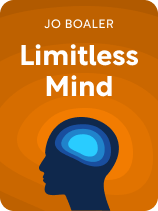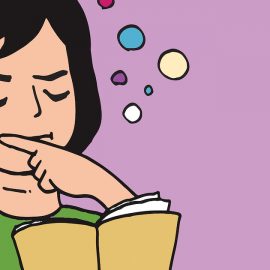

This article is an excerpt from the Shortform book guide to "Limitless Mind" by Jo Boaler. Shortform has the world's best summaries and analyses of books you should be reading.
Like this article? Sign up for a free trial here.
What if everything you know about learning was wrong? How would you approach learning differently, even at this point in your life?
In Limitless Mind, Jo Boaler explains how neuroscience research has overturned our age-old beliefs about how learning works. She argues that it’s time we throw off the false limits imposed by others, ourselves, and outdated models of education.
Continue reading for an overview of this book that’s likely to change the way you think about learning.
Overview of Limitless Mind by Jo Boaler
Most of us were brought up to believe that some people are naturally smarter than others or that we’re born with aptitudes in certain areas and are destined to be bad at everything else. We may have been taught there’s only one approach to learning and that if we struggle with a subject, it means we’re not cut out for it. In Limitless Mind, Jo Boaler writes that, if you’ve received any of these messages in life, then you’ve been done a great disservice.
We used to think that mental development stopped at a very early age. We now understand that the brain is capable of learning new skills and incorporating new ideas throughout our lives. Rather than being a sign of inadequacy, struggling to learn and making mistakes are integral parts of cognitive growth. In order to best serve students and ourselves as we continue to learn throughout our lives, we need to look at learning in a new way.
Boaler is a professor of mathematics education at Stanford University and a lifelong advocate for education reform, particularly for developing new models for teaching math in the classroom to help students overcome their fear of the subject. She co-founded the website youcubed.org to help teachers access neuroscience research and tools to implement new ways to engage students.
Limitless Mind was published in 2019. In this overview of the book, we’ll explore how science has changed the way we understand the brain—how it learns, solves problems, and incorporates new information. We’ll explain Boaler’s assertions about the value of mental attitude over supposed aptitudes to the learning process and why a flexible approach to learning is more productive than older, more rigid practices. We’ll hear what Boaler has to say about the challenges of putting new educational practices into place and why it’s important that we do so.
The Science of Learning
Before we delve into improving how you learn, it’s important to understand how the brain incorporates new skills and information. Neuroscientists have discovered that the brain has much more capacity for development than was believed in the past and that many of the ideas on which the traditional education paradigm is based are flat-out wrong. Our new understanding of the brain’s neuroplasticity reveals that struggling with problems and ideas is beneficial, quick thinking is unimportant, and true learning takes place when different regions of the brain interact.
Boaler explains that scientists and educators have long believed that a person’s mental capacity is a fixed quantity that is set in stone early in life, and certainly by adulthood. Because of this, our educational system has classified students into high, medium, and low achievers, and teaches them (or neglects to teach them) based on their perceived ability. Not only is this premise fundamentally flawed, but it also does a disservice to every student.
Instead, we now understand that the human brain is constantly forming, rearranging, and discarding neural pathways to incorporate new information and skills. As a result, your brain never stops changing, and the belief that you have a built-in aptitude for certain skills or a set level of intelligence is now considered nonsense. Boaler argues that any time you learn a new idea or practice a skill, your brain forms new neural connections, strengthens them with repeated use, and creates new links between preexisting neural pathways. While it’s true that no two people’s brains are the same and that students may exhibit different levels of development, those differences are inconsequential compared to our shared capacity for growth.
Another thing we now understand is that having a hard time learning something is good for brain development. Most of us grew up being penalized for making mistakes in class and developed the belief that struggling with a subject meant that we “weren’t any good at it.” Boaler says this couldn’t be more wrong because struggling through mistakes is what increases your mental capacity. Brain scans prove that students who spend time correcting their mistakes exhibit more mental activity than students who get the right answers to problems on the first try. Therefore, the students who have to fight through a problem are creating more neural connections than the students who don’t.
Boaler uses the idea that challenge is good to highlight a flaw in modern textbooks—they’re purposely designed with quick and simple problems under the assumption that providing students with an “easy win” will encourage them to learn more. Boaler argues that a better approach is to push students with more difficult problems while explaining that making mistakes is not only good but vital to the process of learning. This applies not only to problem-solving but also to questions involving memory. Every time you fight to recall a piece of information, you strengthen the neural connections that make it easier to remember. For this reason, students should be encouraged to test their memory and work through correcting mistakes.
Another thing that happens when you engage in deep learning is that multiple regions of your brain become involved, and when multiple parts of the brain interact—such as your memory, communication, and visual processing centers—your ability to understand and incorporate new information is amplified. Boaler cites research indicating that many people who are considered to be geniuses engage both hemispheres of the brain when solving problems.
Learn Slowly, Not Quickly
Research has also debunked another long-held belief that’s contributed greatly to students’ dislike of learning—the idea that intelligence is tied to quick thinking, when in fact the opposite is true. Boaler explains that much like a computer, your brain has two different types of recall: your active memory (what you’re thinking about right now) and long-term memory. Timed tests engage your short-term active memory, but the information stored there is quickly lost and replaced as soon as it isn’t needed. This is why “cramming for a test” doesn’t result in true learning—you’ve simply trained your brain to temporarily store facts, regurgitate them, then clear them from your mind to make room for the next cramming session.
A different issue with speed-based testing is that it produces anxiety, which shuts down your brain’s active memory. You’ve experienced this when someone asks you an urgent question and you suddenly can’t remember the answer. Boaler says that forcing students into this trap via timed testing creates negative associations around learning. In reality, the experts in any field of knowledge are those who think slowly and deeply about a subject. Slow thinkers outperform quick thinkers in the long run because spending a lot of time to understand a subject engages your brain’s long-term memory and builds understanding by creating more and stronger neural pathways than quick thinking does.
Attitude, Not Aptitude
If science says that we’re capable of learning more and better than we think, then what governs how much and how well we learn if not built-in aptitudes? The answer, according to Boaler, is attitude—the way we think about learning. The aptitude theory of learning has negative effects on both struggling students and those considered “gifted,” while an attitude of growth has many benefits, though it may take effort to relearn how to learn.
Many teachers and parents tell students that they’re simply not good at certain subjects in school. Sometimes this is done with good intentions, such as to offer comfort when a student struggles, but sometimes it’s a symptom of systematic prejudice, such as telling girls and students of color that they’re not good at science and math. Boaler points out that this is a self-fulfilling prophecy—students who are told they’re low achievers tend to give up and stay in that group, and teachers who pass that judgment on a student put less effort into helping them succeed. Studies show that fixed-thinking beliefs—that you’re either good at something or you’re not—can become ingrained as early as the age of three.
Boaler says that even students labeled as “gifted” or told they have an aptitude for a particular subject can suffer from the effects of being labeled. If they believe their abilities are a fixed commodity, then when they start to feel challenged by a subject, they’ll think their talent has run out. Gifted students see any possible failure as a source of shame, so they avoid it. They’ll hide any difficulties they’re having by not asking questions and avoiding difficult tasks. Praising students for being talented or smart encourages them to not challenge themselves so they don’t risk losing their elevated status. Students segregated into high-achieving groups will also compare themselves to others and may feel like frauds if they’re not at the top of the class.
But how do you overcome a lifetime of being taught to believe your talents and intelligence are fixed, and how do we keep from passing these same beliefs along to our children? Boaler insists the key is to adopt the belief that you can learn anything. This isn’t merely a case of wishful thinking—research shows that your beliefs about learning have a direct impact on the way your brain functions. People who adopt the attitude that they can learn show heightened levels of brain activity compared to those who believe their mental acuity is fixed. Plus, if you reframe your attitude toward being challenged by a subject so that you view it as a process of growth instead of a sign of weakness, it will change the entire way you approach learning.
Boaler says that changing your attitude toward challenges and failures is the first step toward broadening your horizons. Instead of approaching failure with judgment, see it as a sign that you’re on the right track. Just as physical exercise can be painful and exhausting, so, too, is struggling with a problem or a concept a sign that you’re working your brain’s metaphorical muscles. Teachers and parents can reframe students’ fears about a subject by reminding them that just because they don’t understand it yet, it doesn’t mean that they won’t with hard work. Self-doubt is a natural part of learning, so students and teachers must all understand that making mistakes should be valued as an essential educational tool.
Different Approaches
While it’s important to adopt a positive attitude toward learning and accept mistakes as part of the process, it’s also important that students be encouraged to approach learning and problem-solving from multiple directions, not just the techniques and interpretations drilled into them by repeating what’s in textbooks. To do this, our education system should place a higher value on conceptual knowledge than rote memorization, and we must also foster true collaboration so that students are exposed to many ways of thinking.
Boaler describes conceptual knowledge as the understanding of how individual ideas relate to each other. The advantage of conceptual understanding is that once it’s achieved, it takes up less memory space in the brain than lists of memorized facts. Furthermore, understanding how different ideas relate to one another creates new avenues for problem-solving and builds a framework for the mind to incorporate even more knowledge.
Yet, that’s exactly how we teach many subjects, from science and math to history and grammar. Students are made to memorize rules for reading, writing, and mathematics without being taught why the rules work. We’re teaching students to think in the hardest way possible. Boaler suggests that we focus on teaching students the core concepts underlying rules and facts so that students can reach beyond memorization and apply those core concepts in creative, flexible ways. Once they understand core concepts, they free up the mental space squandered by memorization and can progress even further.
The final element that Boaler highlights as essential to improved learning is to increase the level of collaboration among students. As discussed before, learning is enhanced when multiple regions of the brain are involved in processing information and solving problems. Group work activates the social networking centers of the brain and gets them involved in the knowledge-building process. It also allows students to see how other students think, which promotes the growth of even more neural pathways as they incorporate and mimic the thought processes of their peers while also finding flaws in their own ways of thinking.
Collaboration has another benefit—it lets students know they’re not alone in their struggles. Boaler says that because of current teaching methods, in which the teacher instructs and students work on their own, most students aren’t aware of the difficulties their classmates go through and falsely assume they’re the only ones with problems. By finding out about their teammates’ different approaches, students learn that if they’re stuck on a problem, there are always different angles from which to solve it. Collaboration builds a foundation for success by letting students know that it’s all right to ask for help while reducing the sense of isolation that leads many people to give up on their education.
Applying the Science
It’s one thing to understand the theoretical basis of how to boost learning, but it’s another to put it into practice. Throughout her book, Boaler gives advice to parents, teachers, and school administrators about how to rethink the education system so that it can better serve the needs of its students. These include celebrating when students work through their challenges, encouraging them to freely make mistakes, using textbooks as merely jumping-off points, and guiding students through effective collaboration. Boaler concludes by reminding us that we never stop being students and that we’re capable of learning throughout our lives.
While such an understanding can help students’ self-confidence, there’s a deeper lesson to be taught. Teachers and parents need to tell students that making mistakes and working hard to correct them is the process by which the brain gets stronger. Students’ efforts must be praised, but in addition to that, teachers must offer productive guidance on how students can improve. Instead of steering students toward subjects where they’re strongest, educators should target the areas in which students have the most problems. In order to dislodge our cultural notions that having difficulty learning is something to be ashamed of, teachers and parents should demonstrate that even they don’t know it all and still have things to learn.
Since making mistakes is a vital part of learning, we have to stop penalizing students for not getting everything right the first time. Boaler suggests replacing fixed test scores with practical feedback on how students can improve. However, because our education system revolves around test scores as a way to measure progress, teachers and administrators will have to work hard to implement changes that don’t punish students’ imperfections. Changing how learning is measured in schools can drive home the message that it’s the process that matters.
Another challenge teachers face is the textbooks they’re assigned, which are designed with problems and questions that promote easy answers, shallow learning, and memorization. Boaler says that math textbooks are particularly egregious in the way they present long lists of problems to be solved quickly by memorized methods, not considered deeply from a variety of angles. Her advice to teachers is to not feel shackled by the book. Instead, she suggests choosing only a handful of problems from the text and challenging students to solve them using a variety of different approaches (numerically, visually, conceptually, and so on) so that they can understand the underlying principles and form new neural connections.
The final key is to teach students the value of collaboration, which goes against the grain of the stereotypical group project in which the “smartest” student ends up doing all the work. Boaler recommends that each group session begins with each student sharing their ideas. The purpose of group exercises should be to show how each student approaches a problem differently. Doing so can open up students’ eyes to the value of multiple perspectives and can even help them build connections across social, ethnic, and gender boundaries. Such activities not only grow each student’s learning, but over time they can be a step to heal divides within society at large.
Never Stop Learning
Because of what we now know about the brain, Boaler reiterates that anyone can form new neural pathways, learn new skills, and explore fields of knowledge at any time in life. Implementing this idea not only helps students in school but also helps adults. Adopting the belief that you can always learn new things can help alleviate the mental decline that many people fear as they age. Recognizing that having difficulties is part of the learning process also frees you from the burden of always having to be right. When you accept that you don’t always have to be an expert and that not understanding something right away isn’t shameful, it lets you open up and ask others for help—which expands both your mind and your circle of support.

———End of Preview———
Like what you just read? Read the rest of the world's best book summary and analysis of Jo Boaler's "Limitless Mind" at Shortform.
Here's what you'll find in our full Limitless Mind summary:
- Why everything you thought you knew about natural abilities is wrong
- Why attitude is more important than aptitude when it comes to learning
- How to apply the science to boost your learning






